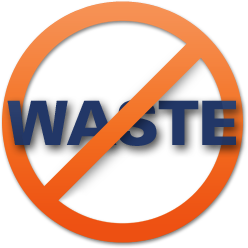Click here for Part 1 of this article.
 Waste is a subject that we all agree on. We don’t like it, it doesn’t benefit us, and we want to eliminate it wherever we can however we can.
Waste is a subject that we all agree on. We don’t like it, it doesn’t benefit us, and we want to eliminate it wherever we can however we can.
Lean Six Sigma professionals feel the same way. They define waste as an action or a step in a process that does not add value for the customer.
Lean Six Sigma helps identify the types of waste listed below and do away with them.
Defects
We all understand what defects are and why they are a waste. Defects happen when an aspect of the product or service fails to meet the customers’ needs or requirements, or causes the customer to be dissatisfied. Defects cost money because they squander resources, require costly rework to correct and cause customers to seek a better-quality solution from your competition.
Solution: Eliminating defects is the reason that the Six Sigma methodology exists. If the defect rates in your product or service are costing your company money and lost customers, summon the power of Six Sigma. A Six Sigma project team will apply the DMAIC model of define, measure, analyze, improve and control to enhance the process and reduce the number of defects that it creates.
Overproduction
When a product or service is profitable, the imperative becomes producing as many as possible. But a mania for high levels of production can create waste. When your company provides customers with more information than they need, it has wasted time and capital to give the customers something they don’t want. Overproducing tangible goods brings the additional waste of the carrying costs to store and insure the excess merchandise.
Solution: The long-term cure for overproduction is to implement a pull production system that changes production philosophy from made-to-stock to made-to-order. Companies that are in tune with the needs of the customer have a much easier time with scheduling and forecasting and don’t require large inventories.
Transportation
The ability to move parts and information through a succession of people who all add value transforms raw materials into something customers are willing to pay for. Movement makes the process appear alive and vital. However, when this movement doesn’t add value to the product or benefit the customer it is a waste of resources.
Solution: Design or redesign the process with an eye for eliminating unneeded movement. Creating and analyzing a detailed process map is critical. Using a visual display helps your team evaluate each step of the process and each movement of material or information. When assessing whether a motion is essential or a waste ask: does this benefit the customer?
Non-Value Added Processing
The acid test that separates worthwhile activities from wasteful ones is expressed in the question: is the customer willing to pay for this? Using this standard helps you identify unneeded process steps.
Solution: Standardizing the work process and overhauling equipment to ensure that manufacturing capability doesn’t exceed customer requirements helps eliminate waste on the production line.
How have these wastes affected your business? Share with us below.



